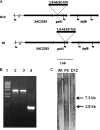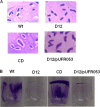Requirement of the galU gene for polysaccharide production by and pathogenicity and growth In Planta of Xanthomonas citri subsp. citri
- PMID: 20118360
- PMCID: PMC2849260
- DOI: 10.1128/AEM.02897-09
Requirement of the galU gene for polysaccharide production by and pathogenicity and growth In Planta of Xanthomonas citri subsp. citri
Abstract
Xanthomonas citri subsp. citri is the causal agent of citrus canker, which has a significant impact on citrus production. In this study, we characterized the galU gene of X. citri subsp. citri. Two galU mutants (F6 and D12) were identified in an X. citri subsp. citri EZ-Tn5 <R6Kgammaori/KAN-2> Tnp transposon library. Rescue cloning, sequence analysis, and Southern blot analysis indicated that both of these mutants had a single copy of the EZ-Tn5 transposon inserted in galU in the chromosome. Further study showed that galU was required for biosynthesis of extracellular polysaccharides (EPS; xanthan gum) and capsular polysaccharide (CPS) and biofilm formation. Mutation of galU resulted in a loss of pathogenicity for grapefruit. The loss of pathogenicity of a galU mutant resulted from its inability to grow in planta rather than from the effect on virulence genes. Quantitative reverse transcription-PCR assays indicated that mutation of galU did not impair the expression of key virulence genes, such as pthA of X. citri subsp. citri. Although D12 had a growth rate similar to that of the wild-type strain in nutrient broth, no D12 population became established in the intercellular spaces of citrus leaves. Coinoculation of a galU mutant with the wild-type strain did not promote growth of the galU mutant in planta. Defects in EPS and CPS production, pathogenicity, and growth in planta of the galU mutant were complemented to the wild-type level using plasmid pCGU2.1 containing an intact galU gene. These data indicate that the galU gene contributes to X. citri subsp. citri growth in intercellular spaces and is involved in EPS and CPS synthesis and biofilm formation.
Figures



Similar articles
-
The gpsX gene encoding a glycosyltransferase is important for polysaccharide production and required for full virulence in Xanthomonas citri subsp. citri.BMC Microbiol. 2012 Mar 9;12:31. doi: 10.1186/1471-2180-12-31. BMC Microbiol. 2012. PMID: 22404966 Free PMC article.
-
Identification of seven novel virulence genes from Xanthomonas citri subsp. citri by Tn5-based random mutagenesis.J Microbiol. 2015 May;53(5):330-6. doi: 10.1007/s12275-015-4589-3. Epub 2015 May 3. J Microbiol. 2015. PMID: 25935304
-
The ColR/ColS two-component system plays multiple roles in the pathogenicity of the citrus canker pathogen Xanthomonas citri subsp. citri.J Bacteriol. 2011 Apr;193(7):1590-9. doi: 10.1128/JB.01415-10. Epub 2011 Jan 21. J Bacteriol. 2011. PMID: 21257774 Free PMC article.
-
High-throughput screening and analysis of genes of Xanthomonas citri subsp. citri involved in citrus canker symptom development.Mol Plant Microbe Interact. 2012 Jan;25(1):69-84. doi: 10.1094/MPMI-05-11-0121. Mol Plant Microbe Interact. 2012. PMID: 21899385
-
Genetic and structural determinants on iron assimilation pathways in the plant pathogen Xanthomonas citri subsp. citri and Xanthomonas sp.Braz J Microbiol. 2020 Sep;51(3):1219-1231. doi: 10.1007/s42770-019-00207-x. Epub 2020 Aug 28. Braz J Microbiol. 2020. PMID: 31848911 Free PMC article. Review.
Cited by
-
Origin of biogeographically distinct ecotypes during laboratory evolution.Nat Commun. 2024 Aug 28;15(1):7451. doi: 10.1038/s41467-024-51759-y. Nat Commun. 2024. PMID: 39198408 Free PMC article.
-
Different Roles of Dioxin-Catabolic Plasmids in Growth, Biofilm Formation, and Metabolism of Rhodococcus sp. Strain p52.Microorganisms. 2024 Aug 17;12(8):1700. doi: 10.3390/microorganisms12081700. Microorganisms. 2024. PMID: 39203542 Free PMC article.
-
The novel virulence-related gene nlxA in the lipopolysaccharide cluster of Xanthomonas citri ssp. citri is involved in the production of lipopolysaccharide and extracellular polysaccharide, motility, biofilm formation and stress resistance.Mol Plant Pathol. 2012 Oct;13(8):923-34. doi: 10.1111/j.1364-3703.2012.00800.x. Epub 2012 Mar 28. Mol Plant Pathol. 2012. PMID: 22458688 Free PMC article.
-
The ATP-dependent RNA helicase HrpB plays an important role in motility and biofilm formation in Xanthomonas citri subsp. citri.BMC Microbiol. 2016 Mar 23;16:55. doi: 10.1186/s12866-016-0655-1. BMC Microbiol. 2016. PMID: 27005008 Free PMC article.
-
Study on enhancing sludge methanogenesis by adding acetylene black and effect on the characteristics & microbial community of anaerobic granular sludge.RSC Adv. 2019 Jul 26;9(40):23086-23095. doi: 10.1039/c9ra03142a. eCollection 2019 Jul 23. RSC Adv. 2019. PMID: 35514522 Free PMC article.
References
Publication types
MeSH terms
Substances
LinkOut - more resources
Full Text Sources
Other Literature Sources

